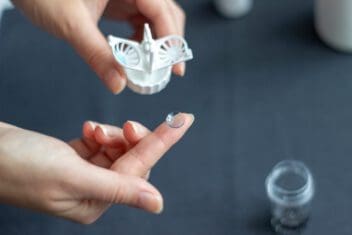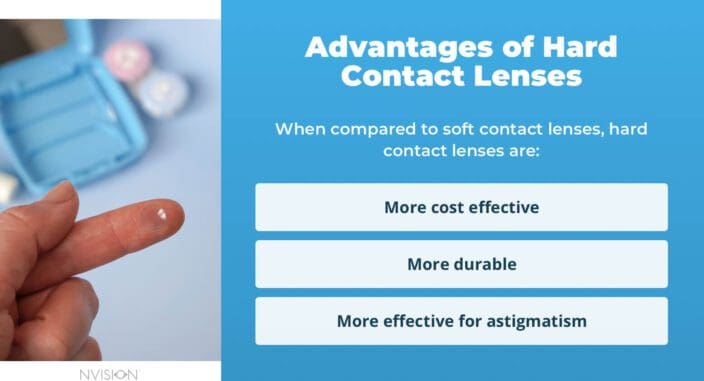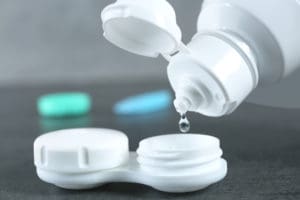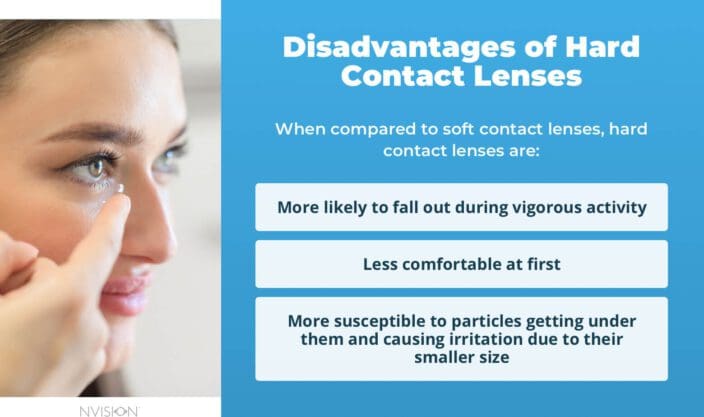RGP (Hard) Contacts: Pros & Cons
Home / Understanding Contacts /
Last Updated:
Rigid gas permeable (RGP) contacts, often just called gas permeable (GP) contacts, are a type of rigid contact lens that offers some distinct advantages over more traditional soft contacts.
RGP contacts are relatively small. They are made of a firm, durable plastic, and they don’t contain water like soft contacts do. They are slightly pricier per contact, although they last significantly longer than soft lenses.
Table of Contents

Hard contacts have their own set of advantages and disadvantages when compared to soft contacts. They tend to be more cost-effective, are durable, and can better help with astigmatism. At the same time, they tend to be less comfortable, especially at first. They can also fall out of the eye more easily during vigorous activity, such as while playing sports.
One notable downside of RGP contacts is that their smaller size and inability to conform to the eye the way soft lenses do makes them more susceptible to particles, such as sand, getting under them and causing irritation. You can mitigate this risk by wearing wraparound sunglasses when near beaches or on windy days.
RGP Contacts
Rigid gas permeable (RGP) contacts have been around since at least the 1960s, although more modern techniques have dramatically improved their ability to allow oxygen to pass through into the eye. This helps to reduce irritation to the eye.
Gas permeable contacts are different from traditional soft lenses in that they are made of a firm, durable plastic that is designed to transmit oxygen. Some of their biggest advantages come from the fact they don’t contain water like soft contacts do.
You deserve clear vision. We can help.
With 135+ locations and over 2.5 million procedures performed, our board-certified eye surgeons deliver results you can trust.
Your journey to better vision starts here.
While they’re not for everyone, RGP lenses tend to be quite cost-effective. They can also be much more comfortable in the long term. These lenses can cost as much as $100 per contact (so twice that for a pair), but they far outlast soft lenses. Monthly disposable lenses can cost as much as 1.5 to 2.5 times the cost of GP lenses, and daily disposables can cost upwards of 3 to 5 times as much.
RGP contacts are fairly hygienic, especially compared to soft contacts. Just note that proper care and maintenance are still essential. The care routine is fairly similar to using soft contacts. Just make sure to familiarize yourself with the recommended procedure and to not switch solutions without making sure it is the right kind for your RGP lenses.

Who Benefits from RGP Contacts?
Gas permeable contacts are considered the best choice for many people, including:
- Some people with astigmatism who cannot benefit from using soft contacts
- People with presbyopia. GP contacts come in different bifocal and multifocal designs. Having many choices is a plus
- People with a condition called keratoconus – the cornea is very cone-shaped, causing extreme vision distortion
- People who are willing to try GP lenses to achieve the sharpest vision
- People who need contacts after refractive surgery
Advantages of Soft Contacts
RGP contacts are not necessarily better than soft contacts. It simply depends on what you need.
As touched on earlier, RGP contacts are usually the best value of the two options, and they can generally be used by anyone who could otherwise benefit from traditional soft contacts. At the same time, soft contacts offer some advantages, including:

- Better initially. It takes time for the eye to get used to RGP contacts. Usually, it takes a few weeks of regular use before you stop feeling something notably odd in your eye. If you are only infrequently going to wear your contacts, you may wish to use soft lenses, which do not have this warmup period.
- Rarely falling out of the eye. Soft contacts are slightly larger than RGP contacts, so they shift less easily. While this is not a huge advantage with regular day-to-day use, this can be a significant factor in sports or physically laborious activities. It simply makes it harder for to accidentally fall out when you are jostled.
- Working well for intermittent wear. For reasons touched on above, soft contacts are good for those who don’t intend to wear their contacts frequently. Overall, they are just easier for your eyes to quickly adapt to. If you are often going to go multiple days without wearing contacts, consider soft lenses.
You deserve clear vision. We can help.
With 135+ locations and over 2.5 million procedures performed, our board-certified eye surgeons deliver results you can trust.
Your journey to better vision starts here.
Advantages of RGP Contacts
RGP lenses have their own advantages beyond the previously mentioned cost and hygiene benefits. Some other big advantages of RGP lenses include:
- Durability. One of the primary reasons RGP lenses are so cost-effective is their durability. RGP lenses last an average of two years, far longer than traditional soft contacts.
- Astigmatism correction. Some people who have astigmatism are told they cannot wear soft contacts. These same individuals can often wear RGP contacts. The rigid nature of RGP contacts helps to provide clear, stable vision correction for those with astigmatism.
- No hydration requirement. RGP lenses do not need hydration, and they do not dehydrate. This is a significant difference compared to soft lenses, which often dehydrate. Dehydrated soft lenses can irritate your eyes and will generally provide worse vision correction.
- Comparable overall comfort. While RGP lenses do have a warmup period, they tend to feel perfectly fine after a few weeks of use. They are smaller than soft lenses, and some people even find they prefer the feel of RGP lenses to soft lenses once they’ve grown used to them. While it may seem like their firm material causes any initial discomfort, it is usually their small size that takes getting used to. RGP lenses are cut pretty precisely to the needs of your eye, so they can fit extremely well in most cases.
- Resistant to damage. RGP lenses need to be kept clean like any type of contact, but they are less likely to tear or break when being handled. The lenses keep their shape, thanks to their firm material, and they are unlikely to damage your eye if used properly. This doesn’t mean they are unbreakable; you should still handle them with care.
Discuss your options further with your eye doctor. Consider your environment and any hobbies as you decide whether soft contacts or hard contacts are better for you.

Notable Downside of Hard Contacts
One of the most notable downsides of hard contacts is that the lenses are more susceptible to intrusions by foreign particles like dust. This is primarily due to the fact that the lenses do not conform to the eye the same way soft lenses do.
This is most often a problem when at the beach or on windy days. The risk can be minimized by wearing wraparound sunglasses. If dust does get in your eye, don’t panic. Don’t rub your eye, as this can cause damage. Instead, rinse the eye with water or saline solution. If you can’t get the dust out of your eye, see a doctor.
Talk to your optometrist or ophthalmologist about the best practice for relieving discomfort and cleaning your lenses. Do not wash your lenses with normal water. This can expose your eye to harmful bacteria.
Because of this downside, people who live in sandy or especially dry (which often means especially dusty) areas may want to discuss whether hard lenses are a good option for them further with their doctor. Consistently getting irritants under your contact lenses is not good for your eyes and could run the risk of causing more serious complications.
Depending on your situation, RGP contacts may be the best option for you. They work well for many people.
You deserve clear vision. We can help.
With 135+ locations and over 2.5 million procedures performed, our board-certified eye surgeons deliver results you can trust.
Your journey to better vision starts here.
References
- What Are GP Contact Lenses? (September, 2018). Contact Lens Manufacturers Association (CLMA).
- Soft vs. RGP Contact Lenses. Canadian Association of Optometrists.
- GP Contact Lens Cost: Are GPs a Better Value? (April, 2013). Contact Lens Manufacturers Association (CLMA).
- Caring for Gas Permeable Contact Lenses. (September, 2016). AAV Media.
- Healthy Contact Lens Wear and Care. (July 26, 2018). Centers for Disease Control and Prevention.
- Bifocal and Multifocal Contact Lenses for Presbyopia and Myopia Control. (March 27, 2020). Journal of Ophthalmology.
This content is for informational purposes only. It may have been reviewed by a licensed physician, but is not intended to serve as a substitute for professional medical advice. Always consult your healthcare provider with any health concerns. For more, read our Privacy Policy and Editorial Policy.
